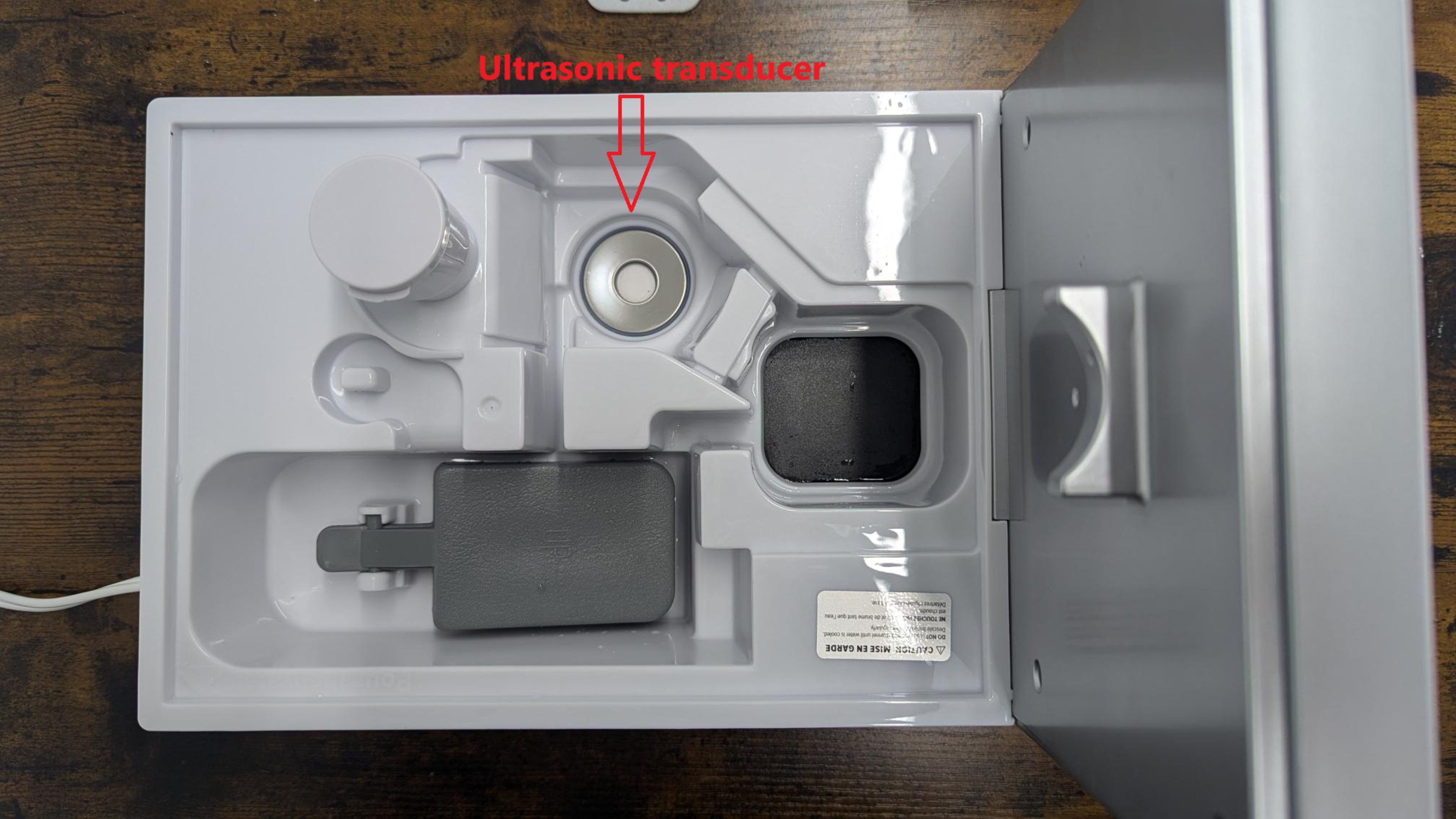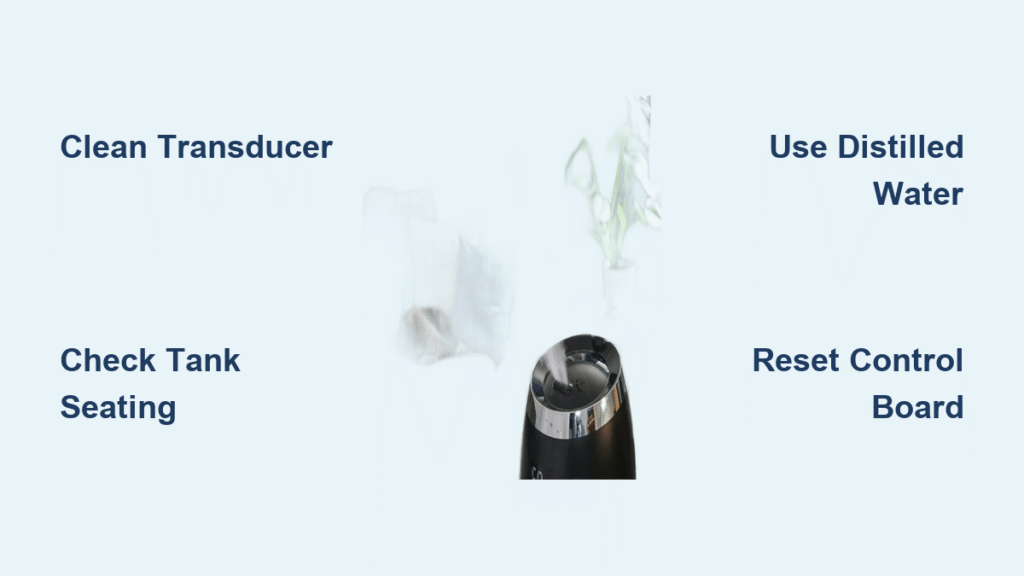Your cool mist humidifier hums on the nightstand, power light glowing steadily—but not a wisp of mist appears. You adjust the settings, refill the tank, and wait anxiously as dry winter air continues to crack your lips and irritate your throat. This exact scenario traps millions of humidifier owners each year, especially when indoor humidity plummets below 30%. The good news? 90% of “no mist” failures stem from just three fixable issues you can resolve before breakfast. Skip the frustration of replacing a $50 unit and follow this proven diagnostic path to restore soothing moisture within minutes.
Ultrasonic Transducer Blocked by Mineral Build-up

When your humidifier powers on but emits zero mist, hardened minerals from tap water are almost certainly smothering the ultrasonic transducer—the critical metal disc that vibrates 1.7 million times per minute to create mist. This silent killer appears as chalky white crust across the disc’s surface, damping vibrations until mist production stops completely. Hard water areas (above 120 ppm) see this failure within 4-6 weeks of regular tap water use.
Why Vinegar Soaking Beats All Other Cleaning Methods
Forget chemical cleaners—vinegar’s acetic acid dissolves mineral bonds without damaging components. Here’s your exact 10-minute rescue protocol:
- Unplug and empty the unit completely—never submerge the base
- Mix solution: Fill tank with equal parts white vinegar and warm water
- Soak critical parts: Pour solution into base until transducer is submerged; let sit 30 minutes (watch for bubbling as deposits dissolve)
- Scrub precisely: Use a cotton swab dipped in vinegar to gently wipe the disc—never use metal tools that scratch the surface
- Triple-rinse: Run 3 full tanks of clean water to eliminate vinegar residue
Pro Tip: Shine a flashlight sideways across the transducer after cleaning. If you see any white specks remaining, repeat the soak—those tiny deposits still block vibration.
When Mineral Build-up Returns Within Days
If scaling reappears rapidly despite vinegar cleaning, your water hardness exceeds 180 ppm. Implement these immediate fixes:
- Switch to distilled water today (costs less than $0.50/gallon at grocery store refill stations)
- Install a demineralization cartridge—compatible models include Honeywell HCM350 and Levoit LV600HH
- Add 1 teaspoon of citric acid powder to each tank fill as a preventive measure
Critical Warning: Continuing with hard water after visible scaling destroys the transducer permanently within 2-3 weeks. That faint buzzing sound you hear? It’s your humidifier’s death rattle.
Power and Water Seat Failures Causing “No Mist” Panic

Before dismantling your unit, rule out these simple oversights causing 40% of “broken humidifier” emergencies. Most occur when rushing to set up the unit during dry spells.
Tank Seating Misalignment: The Silent Mist Killer
Your humidifier’s tank must click audibly into place—a fraction of an inch misalignment blocks the water valve. Follow this foolproof seating test:
- Remove tank and inspect the base for debris
- Hold tank perpendicular to base (not tilted)
- Press down with firm, even pressure until you hear/feel a distinct click
- Gently tug upward—tank should not lift
Red Flag: Water leaking from the base during operation almost always means improper seating. Never force the tank—this cracks the valve mechanism.
Hidden Power Lockouts You’re Overlooking
Modern humidifiers sabotage themselves with safety features that mimic failure:
- Child lock activation: Hold power button for 5+ seconds (not 1-2 taps)
- Low-water cutoff: Refill to above the minimum line—even 1/4 inch low triggers shutdown
- Outlet failure: Plug in a lamp to verify power—GFCI outlets in bedrooms often trip silently
Pro Tip: After confirming power and water, unplug for 60 seconds. This resets the control board’s error memory—a fix for 15% of “dead” units.
White Dust Clouds? You’re Breathing Minerals

That fine white powder coating your furniture isn’t mold—it’s atomized calcium and magnesium from your tap water. This symptom always accompanies transducer scaling and means your humidifier is actively polluting your air.
Immediate Dust Elimination Protocol
Stop using tap water immediately—one tank of distilled water reduces dust by 95%:
- Empty current tank and wipe surfaces with damp cloth
- Fill with distilled water only (not filtered pitcher water—it still contains minerals)
- Run unit for 1 hour to flush residual minerals
- Replace demineralization cartridge if present (models like Vicks UV300)
Long-Term Solution: Keep a dedicated jug for distilled water refills. At $1.50/gallon, it costs less per month than replacing filters ruined by hard water. Within 48 hours, dust accumulation stops completely.
Musty Odors Requiring Urgent Action
A sour, damp smell means bacteria or mold has colonized your water tank or wick filter—posing real health risks beyond nuisance odors. Don’t confuse this with the harmless vinegar scent after cleaning.
Odor Eradication Sequence (Works in 24 Hours)
Daily: Empty tank before water becomes room temperature—bacteria multiply fastest in warm stagnant water
Deep clean: Fill tank with 1 cup 3% hydrogen peroxide + water; run 30 minutes, then rinse 3x
Replace filter: If unit uses evaporative wicks (like Holmes HMA2401), install new filter immediately—soaked filters can’t be sanitized
Critical Threshold: If odor persists after 3 hydrogen peroxide cycles, discard the unit. Mold has penetrated electronics where cleaning can’t reach.
Water Leaks Under Unit: 3 Leak Points to Inspect
Puddles spreading under your humidifier typically trace to one of these failure points—each requiring different fixes.
Tank Crack Detection Method
Hold empty tank against bright window light—hairline fractures appear as thin black lines. Most common near handle or base seam. Do not attempt epoxy repairs; pressure changes will reopen cracks within days.
Gasket Failure Signs
Inspect the rubber O-ring where tank meets base:
– ✅ Good: Round, springy cross-section
– ❌ Bad: Flattened, cracked, or hardened texture
Fix: Order genuine replacement gasket from manufacturer (costs $2-5). Generic parts often leak.
5-Minute Diagnostic Flowchart for No-Mist Emergencies
Follow this exact sequence—no guesswork needed:
- Power test: Plug phone charger into same outlet (60 seconds)
- Water seating: Remove/reseat tank with firm click (30 seconds)
- Transducer clean: Vinegar soak + cotton swab scrub (10 minutes)
- Reset: Unplug 60 seconds, restart (1 minute)
- Result: Mist returns → problem solved. No mist → replace unit.
Skip straight to Step 3 if you see white crust on the metal disc—it’s the culprit 9 times out of 10.
Preventive Maintenance That Doubles Humidifier Life
Daily (30 seconds): Empty tank before bed, quick rinse with tap water—stagnant water breeds bacteria overnight
Weekly (8 minutes): Full vinegar soak + transducer scrub—prevents scaling before it starts
Before Storage: Run empty with vinegar solution, then dry 24 hours in open box—stops mold during off-season
Pro Tip: Place a silica gel packet in the storage box to absorb residual moisture—prevents mustiness.
Water Type Impact: Your Lifespan Decider
| Water Source | White Dust | Scaling Speed | Humidifier Lifespan | Cost/Month |
|---|---|---|---|---|
| Tap Water (Hard) | Heavy | 2-4 weeks | 1-2 years | $0 |
| Filtered Pitcher | Moderate | 6-8 weeks | 2-3 years | $5-10 |
| Distilled | None | 6+ months | 4-5 years | $3-6 |
| Demineralization Cartridge | Light | 2-3 months | 3-4 years | $8-12 |
Reality Check: Using distilled water saves $100+ over 5 years by avoiding premature replacement and filter costs.
Replace vs. Repair Decision Guide
Repair immediately:
– Cracked tank (order OEM replacement)
– Worn gasket (costs less than $5)
– Clogged mist outlet (clean with toothpick)
Replace now:
– No mist after vinegar soak + reset
– Unit older than 3 years
– Cracks in base unit (not tank)
– High-pitched whining noise
Critical Insight: Transducer replacement requires circuit board disassembly—voids safety certifications and costs 70% of a new unit. Not worth the risk.
Final Action Plan: Your Next 15 Minutes
- Immediately: Unplug unit and check transducer for white crust (60 seconds)
- If crust present: Start vinegar soak—your fix is confirmed (10 minutes)
- After cleaning: Refill with distilled water and verify mist (2 minutes)
- If no mist: Order replacement—your transducer is dead (2 minutes)
Long-Term Lifesaver: Switch exclusively to distilled water. This single change transforms your humidifier from a seasonal disposable into a 5-year workhorse while eliminating white dust and scaling permanently. Remember—when your cool mist humidifier isn’t working, the solution is almost always sitting in your kitchen cupboard (white vinegar) or grocery aisle (distilled water). Don’t replace it before you’ve tried these proven fixes.





